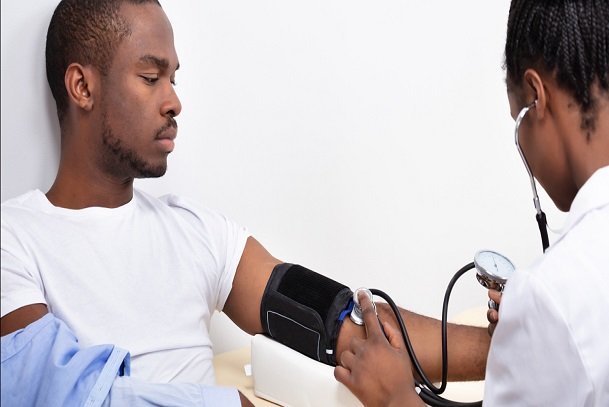 Wash your hands regularly and wear a face mask.
Learn more
Wash your hands regularly and wear a face mask.
Learn more

Generally, evaluating high blood pressure primarily focuses on accurate examination of the patient’s blood pressure, inquiries on his/her medical history, physical examination, and obtaining results of routine laboratory tests. Doctors can listen to heartbeats using a stethoscope.
Therefore, it is essential to regularly monitor blood pressure, especially if it has ever been high or above the "normal" range, or if there is a family history of hypertension. Most doctors recommend that all adults 18 years or older be examined for hypertension.
Physical Examination (Blood Pressure Measurement)
Blood pressure can be measured in a hospital, licensed pharmacy, health event, or at home using a home testing kit for blood pressure. Accurate measurement of blood pressure is the key to diagnosis. Several determinations should be made over several weeks.
Blood pressure is checked using a cuff, usually placed around the arm. The cuff must fit. Blood pressure readings can vary if it is too big or too small. The cuff is inflated using a small hand pump or a machine.
In a clinical setting (for example, an outpatient clinic), blood pressure is measured with a device known as a sphygmomanometer, which consists of a stethoscope, arm cuff, dial, pump, and valve, while maintaining the arm cuff position at the heart level.
The patient should rest quietly with his/her back supported and legs uncrossed for at least 5 minutes before the measurement or test. Also, it is best to relax and avoid talking while the test is being carried out.
Blood pressure is measured in millimeters of mercury (mm Hg). A blood pressure reading has two numbers: the systolic and diastolic pressure.
During the test:
High blood pressure (hypertension) is diagnosed if the blood pressure reading is equal to or greater than 130/80 millimeters of mercury (mm Hg). A diagnosis of high blood pressure is usually based on the average of two or more readings taken on separate occasions.
Sometimes the bottom blood pressure reading is normal (less than 80 mm Hg) but the top number is high. This is called isolated systolic hypertension. It is a common type of high blood pressure in people older than 65.
Blood pressure may increase or decrease, depending on age, heart condition, emotions, activity, and the medications one takes. One high reading does not mean one has high blood pressure. It is necessary to measure blood pressure at different times, while one is resting comfortably for at least five minutes. To make the diagnosis of hypertension, at least three readings that are elevated are usually required.
In a non-clinical setting, having a raised blood pressure reading in one (1) test does not necessarily mean a patient has high blood pressure. Blood pressure can fluctuate in a day. Stress or anxiety especially while visiting a doctor can also raise blood pressure.
Once there is a high reading, it can be recommended that the patient take some readings with a 24-hour monitor that checks the blood pressure throughout the day. This will help to confirm whether a patient has consistent high blood pressure. This is known as Ambulatory or 24-hour blood pressure monitoring.
Suggestions to the General Public
Home blood pressure measurement is very useful for improving the treatment of patients, and also for preventing an excessive or insufficient antihypertensive effect of drugs. A special instrument for this (Omicron) is available to do this.
It is recommended that it should be used to measure blood pressure within 1 hour of waking, after urination, after 1–2 minutes of rest in a seated position, and before breakfast in the morning. It is advisable that every adult who suspects or who has been diagnosed with hypertension purchase this.
Laboratory Tests for Those with Hypertension
Blood Tests
Chest X-ray
This is used to check if the heart is enlarged.
Electrocardiogram (ECG or EKG)
This quick and painless test measures the heart's electrical activity. It can tell how fast or how slow the heart is beating. During an electrocardiogram (ECG), sensors called electrodes are attached to the chest and sometimes to the arms or legs. Wires connect the sensors to a machine, which prints or displays results.
Echocardiogram
This noninvasive exam uses sound waves to create detailed images of the beating heart. It shows how blood moves through the heart and heart valves.
The echocardiogram is only done if ECG and Chest X-ray show an enlarged heart.